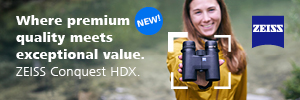A little over fifteen years ago our car was broken into and our binoculars stolen. I lost a Dialyt 7X, 42; my wife lost her SLC 7X, 42. We decided to put all the insurance money into a Zeiss 7X, 42 T*FL.
We would not then or now be able to afford an alpha binocular on our normal incomes.
We were later able to replace the Swarovskis with an identical pair.
I have, in fact, looked through a binocular I thought was shockingly better (it was a Leica 7X, model unremembered, at the trade show at Cape May).
I don't use my 7X, 42 every day: I don't leave them in the car; I don't check them on an airplane; I don't take them canoeing or backpacking. But I use them whenever that tiny percentage of "better" might make a difference: when I am searching for a known rarity; when I'm on a formal count; when I'm scanning flocks of LBBs.
My wife's scope is also a has-been alpha, a Swarovski STS80 HD. Because of hip and back issues, I carry a Diascope 65 T*FL and live with its "inferiority" to the Swarovski. We could not afford to replace either with an equal quality scope and consider ourselves very lucky to have been able to acquire these well before retirement.
We keep replaceable optics in the car and around the house for casual observation. Although they are entirely serviceable, none of these single binoculars could match the performance of the 7X, 42 T*FL.
Aside from my allegiance to unaffordable quality is excellent service from Zeiss over the years with other optics.
So, at age 76, I hope I will never be tempted to part with my Zeiss 7X, 42 T*FL. I could never come close to replacing it.
Bob M.









